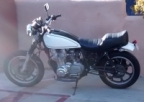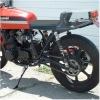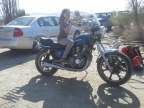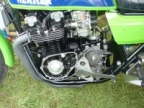Hobart 210 MVP - novice first flux core welds
- blakeem
-
 Topic Author
Topic Author
- Offline
- User
-

Registered
- Posts: 122
- Thanks: 3
Hobart 210 MVP - novice first flux core welds
25 Aug 2016 11:23
I wanted to learn to weld so I can attach a exhaust bracket to my kz and fill some small holes in the frame. I choose flux core because I mostly weld outside and I could do it out of the box. I definitely want to try to use gas in the future (for cleaner looking welds) but for now I'm up to the challenge of flux core.
I got the Hobart 210 MVP because it can do 220v and 110v and can weld just about anything I could possibly want in the future. I've read that starting with a good welder makes learning much easier so I didn't want to cheap out.
Here were my first welding attempts on some rusty scrap steel I found. All tests were done using the settings above. I just used a quick wire brush on them to clean the slag.
Now my experimental stuff, mostly just messing around to see what works and how it looks.
I got the Hobart 210 MVP because it can do 220v and 110v and can weld just about anything I could possibly want in the future. I've read that starting with a good welder makes learning much easier so I didn't want to cheap out.
Here were my first welding attempts on some rusty scrap steel I found. All tests were done using the settings above. I just used a quick wire brush on them to clean the slag.
- The first weld I went too fast and the wire wasn't feeding smooth
- I adjusted the wire feed wheel pressure. My weld wasn't hot enough
- I moved really close (more power!) for the 3rd and blew the breaker in the garage (it's only 15 amp)
- Next I moved the welder into the back yard and used the outlet from the kitchen (40 amp) and got far better penetration on the last two welds
Now my experimental stuff, mostly just messing around to see what works and how it looks.
- The first one I tried going back and forth, ugly but good penetration
- 2nd was smooth and steady.
- The last two I was trying to make the bead look nice but I was moving too fast, I need to try and stack it closer together.
Please Log in or Create an account to join the conversation.
- blakeem
-
 Topic Author
Topic Author
- Offline
- User
-

Registered
- Posts: 122
- Thanks: 3
Re: Hobart 210 MVP - novice first flux core welds
25 Aug 2016 11:23
Here are closeups of what I think were the best welds out of about a dozen of my first attempts. They are ugly but should become better with practice. The welds being strong is what's most important to me.
Here was my first attempt at testing the strength of a weld. I didn't weld it straight nor did I make a groove however it was strong enough that both sides bent and the weld held strong.
I'm maxed on my power output without switching to 220v. I think I could increase the wire speed from 50-60 to get a hotter weld (from what I've read). I look forward your feedback and tips.
I never knew welding could be so much fun. :woohoo:
Here was my first attempt at testing the strength of a weld. I didn't weld it straight nor did I make a groove however it was strong enough that both sides bent and the weld held strong.
I'm maxed on my power output without switching to 220v. I think I could increase the wire speed from 50-60 to get a hotter weld (from what I've read). I look forward your feedback and tips.
I never knew welding could be so much fun. :woohoo:
The following user(s) said Thank You: Patton
Please Log in or Create an account to join the conversation.
- loudhvx
-

- Offline
- KZr Legend
-

Registered
- Posts: 10864
- Thanks: 1619
Re: Hobart 210 MVP - novice first flux core welds
25 Aug 2016 12:14
Nice rig. I love my Hobart Handler 140 (small 120v version of yours). For me, working with scrap metal, the biggest factor is cleaning the metal. 90% of what you find, that isn't rusty, has some zinc plating. That is a really hard to strip off enough to get a clean weld, and really shouldn't be welded at all, but if you do, definitely do it outside so you don't breathe the fumes.
1981 KZ550 D1 gpz.
Kz550 valve train warning.
Other links.
Kz550 valve train warning.
Other links.
The following user(s) said Thank You: blakeem
Please Log in or Create an account to join the conversation.
- blakeem
-
 Topic Author
Topic Author
- Offline
- User
-

Registered
- Posts: 122
- Thanks: 3
Re: Hobart 210 MVP - novice first flux core welds
25 Aug 2016 12:42loudhvx wrote: Nice rig. I love my Hobart Handler 140 (small 120v version of yours). For me, working with scrap metal, the biggest factor is cleaning the metal. 90% of what you find, that isn't rusty, has some zinc plating. That is a really hard to strip off enough to get a clean weld, and really shouldn't be welded at all, but if you do, definitely do it outside so you don't breathe the fumes.
I was using a wire brush by hand where I was welding but it's hard to get everything off. I figured if I can weld good on this it would be even better when it's perfectly clean frame wiped down with isopropyl alcohol. I'll use my angle grinder to get to shiny bare metal for my next tests.
I been welding outside so I don't even notice the smoke. I don't have enough amps in the garage so I have no choice but to weld in the backyard. I keep the welder in my bedroom closet :laugh:
Please Log in or Create an account to join the conversation.
- SWest
-

- Offline
- Sustaining Member
-

Registered
- 10 22 2014
- Posts: 23516
- Thanks: 2938
Re: Hobart 210 MVP - novice first flux core welds
25 Aug 2016 13:56
A little trick. When you come to the end of your weld, don't pull away, go back a little then stop, it will look better.
Steve
Steve
Z1b1000 1975 Z1b
kzrider.com/forum/11-projects/598262-kz-...-will-it-live#672882
kzrider.com/forum/2-engine/597654-poser?start=240#704229
kzrider.com/forum/11-projects/598262-kz-...-will-it-live#672882
kzrider.com/forum/2-engine/597654-poser?start=240#704229
The following user(s) said Thank You: TwoCam, blakeem
Please Log in or Create an account to join the conversation.
- blakeem
-
 Topic Author
Topic Author
- Offline
- User
-

Registered
- Posts: 122
- Thanks: 3
Re: Hobart 210 MVP - novice first flux core welds
25 Aug 2016 14:09swest wrote: A little trick. When you come to the end of your weld, don't pull away, go back a little then stop, it will look better.
Steve
Yep, I forgot to do that for many of the welds. I did do it for the ones in the close up pictures and my strength test. For me the beginning and the end of the weld are the hardest to make look uniform, I'll need to work on that.
Please Log in or Create an account to join the conversation.
- I_Tig_in_piece
-

- Offline
- User
-

Registered
- Posts: 170
- Thanks: 14
Re: Hobart 210 MVP - novice first flux core welds
21 Oct 2016 01:24
+1 to what Loudhvx said for cleanliness in any process of welding (except underwater maybe?) I only really Mig when i gotta bend up a cage in less than a timely manner or for random jobs like...say a utility rack for a flat bed or an occasional open trailer mod/or repair, I'm more of a Tig monster which is the slowest but prettiest process.  I'd stick with the fluxcore wire and not even bother with adding the gas IMO. The gas does help with the look of the weld and slag that you chip away (but you're gonna wire brush or sand it down a bit anyways right) also reducing the projectile splatter that can potentially land on your crotch without you knowing. With the addition to gas you'll have another heavy'ish/bulky item that you'll need to cart around with your rig or realize that now you'll need a cart?
I'd stick with the fluxcore wire and not even bother with adding the gas IMO. The gas does help with the look of the weld and slag that you chip away (but you're gonna wire brush or sand it down a bit anyways right) also reducing the projectile splatter that can potentially land on your crotch without you knowing. With the addition to gas you'll have another heavy'ish/bulky item that you'll need to cart around with your rig or realize that now you'll need a cart?  4 P's....Patience practice practice practice. I'm stil learning new things after 12yrs of Tig welding.
4 P's....Patience practice practice practice. I'm stil learning new things after 12yrs of Tig welding.
ed
ed
Cheap labor isn't skilled, skilled labor isn't cheap.
1980 KZ440a. I went green.
If you yourself are building an older bike and can see it through till you're riding it, that's proof you have patience.
1980 KZ440a. I went green.
If you yourself are building an older bike and can see it through till you're riding it, that's proof you have patience.
Please Log in or Create an account to join the conversation.
- barney
-

- Offline
- User
-

Registered
- Posts: 443
- Thanks: 36
Re: Hobart 210 MVP - novice first flux core welds
21 Oct 2016 06:34
I like the 220V unit using argon mix gas . Welded exceptionally well
Barney
Barney
Please Log in or Create an account to join the conversation.
- westmiltonfab
-

- Offline
- User
-

Registered
- Posts: 107
- Thanks: 23
Re: Hobart 210 MVP - novice first flux core welds
21 Oct 2016 13:06
You can also apply this trick as you begin your weld. Start about an inch in front of where you want to start, back up to your starting place and begin your bead. So what you have done is you have pre-heated your part and now the beginning of your weld will be more uniform with your bead. Here is a trick for you. You can weld heavier metal more easy if you pre-heat with a propane torch. Get your weldment hot then light into it. It really helps with penetration.
One last thing. Go with gas. Yes with flux you can get by without but there are so many pros than cons when it comes down to it. One being is that you can easily see your weld deposit without flux. Good welders can read the metal vs the flux but that's an art all in itself.
Also I like what the tig guy is saying but to me that's the hardest process to learn.
Keep having fun with it. It kept me shitten since 1982
One last thing. Go with gas. Yes with flux you can get by without but there are so many pros than cons when it comes down to it. One being is that you can easily see your weld deposit without flux. Good welders can read the metal vs the flux but that's an art all in itself.
Also I like what the tig guy is saying but to me that's the hardest process to learn.
Keep having fun with it. It kept me shitten since 1982
1980 Kz1000 A4 21000 miles
2005 Road King 150,000 miles
1968 CL125 Honda 11,000 Miles
2005 Road King 150,000 miles
1968 CL125 Honda 11,000 Miles
Please Log in or Create an account to join the conversation.
- TwoCam
-

- Offline
- User
-

Registered
- Posts: 133
- Thanks: 57
Re: Hobart 210 MVP - novice first flux core welds
01 Jul 2017 20:48
For a first time welding doesn't look too bad. Flux core is fine, not as pretty as gas ..... unless you have been welding for a while. It's still a strong weld either way. From the pics....... go a little slower with the torch, watch the puddle of molten metal....... you will see what's going on. Both pieces have to be molten, do a slight side to side motion with the torch handle, so everything is flowing together. Look like you could also use a bit more heat and possibly less wire speed feed. Just practice as much as you can!!! Play with heat and feed settings. If you have a buddy that is good at welding.... let them set thewelder for you and make some good weld passes...... then you give it a shot. See what you need to do to match their welds. I personally weld most everything very hot....... lots of penetration........ like so much that many people will blow holes the way I set my welder...but I have been welding for 25 plus years. Self taught too..... it's a learning experience and the only way to get good st it is to play around. One more thing, everyone has their own technique. Do what works best for you. Your machine should have some basic setting as a starting point in the manual or on the machine. Those setting are not perfect, but will surely get you started in the right direction. Wire size makes a difference too. Thin wire needs more feed for a set heat range....wire size is important to, depending what gauge steel your welding .watch some YouTube videos for the machine you have too. Lots of good info out there. Some poor info too....good luck! Make some yard art while learning.......
The following user(s) said Thank You: GPz550D1, old_kaw
Please Log in or Create an account to join the conversation.
- old_kaw
-

- Offline
- User
-

Registered
- Posts: 929
- Thanks: 270
Re: Hobart 210 MVP - novice first flux core welds
17 Feb 2018 14:18 - 17 Feb 2018 14:19westmiltonfab wrote: You can also apply this trick as you begin your weld. Start about an inch in front of where you want to start, back up to your starting place and begin your bead. So what you have done is you have pre-heated your part and now the beginning of your weld will be more uniform with your bead. Here is a trick for you. You can weld heavier metal more easy if you pre-heat with a propane torch. Get your weldment hot then light into it. It really helps with penetration.
One last thing. Go with gas. Yes with flux you can get by without but there are so many pros than cons when it comes down to it. One being is that you can easily see your weld deposit without flux. Good welders can read the metal vs the flux but that's an art all in itself.
Also I like what the tig guy is saying but to me that's the hardest process to learn.
Keep having fun with it. It kept me shitten since 1982
Of all of the excellent replies in this thread. this is spot on IMHO. The no gas is fine, for emergency repairs, and basic welding, but reversing the welder poarity and switching to argon shielding gas make for much cleaner welding, with practically no splatter, unless trying to weld rusty parts, of which nothing will help aside from grinding off the rust. Rust and rusty metal, does not weld. Period.
I have a small Lincoln "weld pak 100" that I converted to gas by buying a gas valve, harbor freight regulator setup and a large bottle of argon gas from Praxair in St. Louis. This little welder works great for the occasional welds I need to make in day to day fabrication and repair.
I used it to to fix a badly cracked up Honda mower base in the pic. (cracked from a bent crankshaft). I also welded on fender washer on both sides, that I bolted in to place. Salvaged another piece of junk to make another pass..
This mower base was cracked up bad. Some of the welds could look better, but it was good welding practice.
1981 Kawasaki Kz1000K1
Located in the Saint Louis, Missouri Area.
Located in the Saint Louis, Missouri Area.
Attachments:
Last edit: 17 Feb 2018 14:19 by old_kaw.
Please Log in or Create an account to join the conversation.
- old_kaw
-

- Offline
- User
-

Registered
- Posts: 929
- Thanks: 270
Re: Hobart 210 MVP - novice first flux core welds
17 Feb 2018 14:26blakeem wrote:
I'm maxed on my power output without switching to 220v. I think I could increase the wire speed from 50-60 to get a hotter weld (from what I've read). I look forward your feedback and tips.
I never knew welding could be so much fun. :woohoo:
Also,, electric is my thing. Ohms law states the lower the current, the higher the voltage. Inversely proportional values. Sooo at 120 volts it is pulling more current than at 240 volts. It also transfers into the transformer wingdings inside your welder. That sad, run a dedicated 240 volt circuit for your welder, and your welding will improve. Mine is so much happier when it eats the proper diet.
1981 Kawasaki Kz1000K1
Located in the Saint Louis, Missouri Area.
Located in the Saint Louis, Missouri Area.
Attachments:
Please Log in or Create an account to join the conversation.
Moderators: Street Fighter LTD











